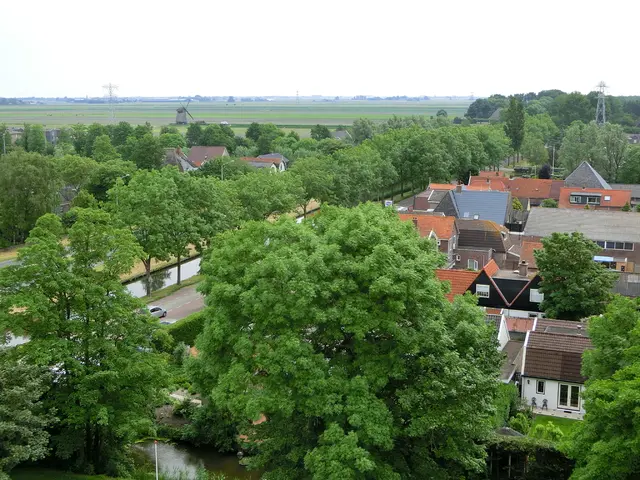Landscaping Around Black Walnut Trees: Identifying Which Plants to Favor or Shun
Crafting a lush, charming garden under a black walnut tree may seem like an insurmountable task due to the tree's juglone production. But fear not; with these creative tips and a knowledge of juglone-tolerant plants, you can transform that barren space into a vibrant extension of your outdoor sanctuary.
Mastering Black Walnut Landscapes
Juglone's Reign: The Culprit Behind Garden Death
Black walnut trees produce juglone, a chemical that aims to protect the tree from external aggressors. Juglone is released from the roots and can be found in smaller concentrations in the leaves, bark, wood, and nut hulls. Despite other trees also producing juglone, black walnut trees are particularly notorious for their destructive effects.
Plants sensitive to juglone display yellowed and wilting leaves, often leading to their demise. Juglone hinders respiration, resulting in plants being deprived of nutrients, water, energy, and the ability to divide cells. Juglone is not water-soluble, so it doesn't travel far into the soil. Plants within the dripline or the edge of the canopy are most susceptible to juglone. However, the toxic zone around a mature black walnut tree can stretch up to 50 to 60 feet from the trunk due to the far-reaching roots. After removal, decaying roots can still release juglone for several years.
Turning Adversity into Opportunity
Plant Far Apart
The most evident solution is to locate plants at least 50 feet away from the black walnut tree trunk. Plants with higher juglone tolerance can survive closer to the tree but will have a greater likelihood of success the farther away they are planted.
Install Raised Beds
To sneak plants in nearer to the tree, consider installing raised beds. This will limit root contact, hence reducing juglone exposure. For optimal results, line the bottom of each raised bed with landscape fabric before filling it with topsoil. Keep the beds outside the tree's dripline to avoid damaging tree roots. Lightweight flowerpots can also be placed under the canopy for a more versatile plant varieties.
Raised beds deliver numerous benefits, including improved drainage, faster soil warming for earlier planting, decreased weed activity, and easier access. Their shape and construction materials are wide-ranging, so you won't feel hemmed in by this idea.
Boost Soil Health
Although juglone from leaves and nut hulls usually break down in the soil, poor drainage and damp conditions can cause juglone to accumulate, making it less likely for any other plants to thrive. On the contrary, well-drained, well-aerated soil with a healthy microbe population can accelerate juglone decomposition.
Enhance planting conditions by incorporating organic matter, such as compost, into the soil before planting. Be gentle while digging to avoid damaging tree roots, and add only about two inches of organic matter to prevent suffocating tree roots. Keep the area around the black walnut tree clean by removing fallen leaves, hulls, and twigs to minimize juglone levels.
Relax in the Shade
Embrace the cool shade cast by your black walnut tree and set up a bench or comfortable seats beneath its branches. Imagine enjoying a refreshing drink or a good book on a hot summer day. A bamboo mat can minimize mud underfoot, and it could even be an ideal spot for a child's swing.
Decorative items, such as figurines, garden gnomes, or toad houses could find a home under the black walnut tree, along with other nonliving items. A tiny door next to the tree trunk could even suggest a cozy residence for your gnome. Decorative stones or shells can also help fill spaces where plants cannot.
Choose Plants That Coexist with Juglone
Some plants exhibit resistance to juglone under various conditions. Factors affecting a plant's tolerance to juglone include soil conditions, juglone concentrations, and plant health. While plants with higher juglone tolerance may grow under the canopy, they will have a greater likelihood of survival the farther away from the trunk they are planted.
Plants that Grow Well Under Black Walnut Trees (extracted from Penn State Extension)
Juglone-Sensitive Species to Avoid
Fragile Blooms
- Blue false indigo
- Columbine
- Forget-me-not
- Lily
- Peony
- Petunia
Sensitive Vegetables
- Asparagus
- Eggplant
- Pepper
- Potato
- Rhubarb
- Tomato
Vulnerable Berries
- Apple
- Blackberry
- Blueberry
- Grape
- Pear
- Strawberry
Juglone-Resistant Trees, Shrubs, and Vines
- Maples
- Oaks
- Hickories
- Hemlock [3]
- Arrowwood [5]
- Pawpaws and blackcap raspberries [2]
Embrace the Challenge and Let Your Garden Grow
While the black walnut tree in your yard may present an initial daunting landscaping challenge, you now know that there are numerous plants that can thrive in its presence. Happy planting, and enjoy your new, lively garden!
Our Valued Contributor
- Serena Manickam Serena Manickam is a freelance editor and writer, as well as a sustainable market gardener in rural Virginia. She holds a BA in environmental science and runs Fairydiddle Farm, a small market garden where she produces no-spray produce and herbs to sell at a local farmer's market.
References:[1] Hamilton, S. (2016, May 29). Walnut trees: The problem neighbors of landscaping. Retrieved April 12, 2023, from https://www.extension.org/articles/26286[2] Penn State Extension. (2010, August 5). Juglone in black walnut roots - A barrier to understory trees, shrubs, and groundcover plants. Retrieved April 12, 2023, from https://extension.psu.edu/juglone-in-black-walnut-roots--a-barrier-to-understory-trees-shrubs-and-groundcover-plants[3] Keener, J.V. (2017, June 9). Hemlock Wooly Adelgid. Retrieved April 12, 2023 from https://extension.pdxcoumlibraries.org/content/hemlock-woolly-adelgid[4] Paige, S. (2016, August 24). WHY JUGLONE IN BLACK WALNUT TREE ROOTS IS DEADLY TO MANY PLANTS. Retrieved April 12, 2023, from https://gardeningchannel.com/deadly-juglone-in-black-walnut-tree-roots/[5] Chen, G. (2019, April 24). Arrowwood viburnum. Retrieved April 12, 2023, from https:// Extension.psu.edu/arrowwood-viburnum[6] Reece, C. (2020, March 3). Pawpaw Tree: Growing Your Own Pawpaws. Retrieved April 12, 2023, from https://www.pennstateextension.org/columns/home-gardening-columns/pawpaw-tree-growing-your-own-p[7] Covington, B. (2021, August 2). Blackcherry Author: Brad Covington. Retrieved April 12, 2023, from https://www.blackcherryblog.com/author/bradcovington/[8] Darvill, B. (2018, July 14). Black walnut juglone in the garden - your black walnut root zone and how to landscape with it. Retrieved April 12, 2023, from https://thegardencontinuum.com/black-walnut-juglone-in-the-garden-your-black-walnut-root-zone-and-how-to-landscape-with-it/
- With the knowledge of juglone-tolerant plants and creative tips, transform the barren space under a black walnut tree into an organic vegetable garden, planting rows of carrots, peas, or lettuce, that are known to thrive in the challenged soil.
- To decorate the landscaping, consider embedding herb plants such as thyme, chives, or rosemary into the paths leading to the raised beds, enhancing the home-and-garden lifestyle and improving the overall scent of the garden.
- Install decorative raised beds filled with compost and topsoil, planting organic basil, mint, or oregano, along the edge of the dripline to create a lush, vibrant herb garden.
- Lavish the black walnut tree's base with beautiful decor, such as decorative rocks, glass sculptures, or solar-powered fence lights, creating an enchanting ambiance in the home-and-garden surrounding.
- Flank the underside of the black walnut tree with flowering plants that thrive in the shade, such as hostas, impatiens, or bleeding hearts, brightening the area and adding to the garden's charm.
- Create a cozy sunroom using raised beds filled with geraniums, petunias, or calibrachoa, positioned off the back of the house with western exposure, allowing the plants to bask in afternoon sunlight while keeping them safe from the juglone released by the black walnut tree.




